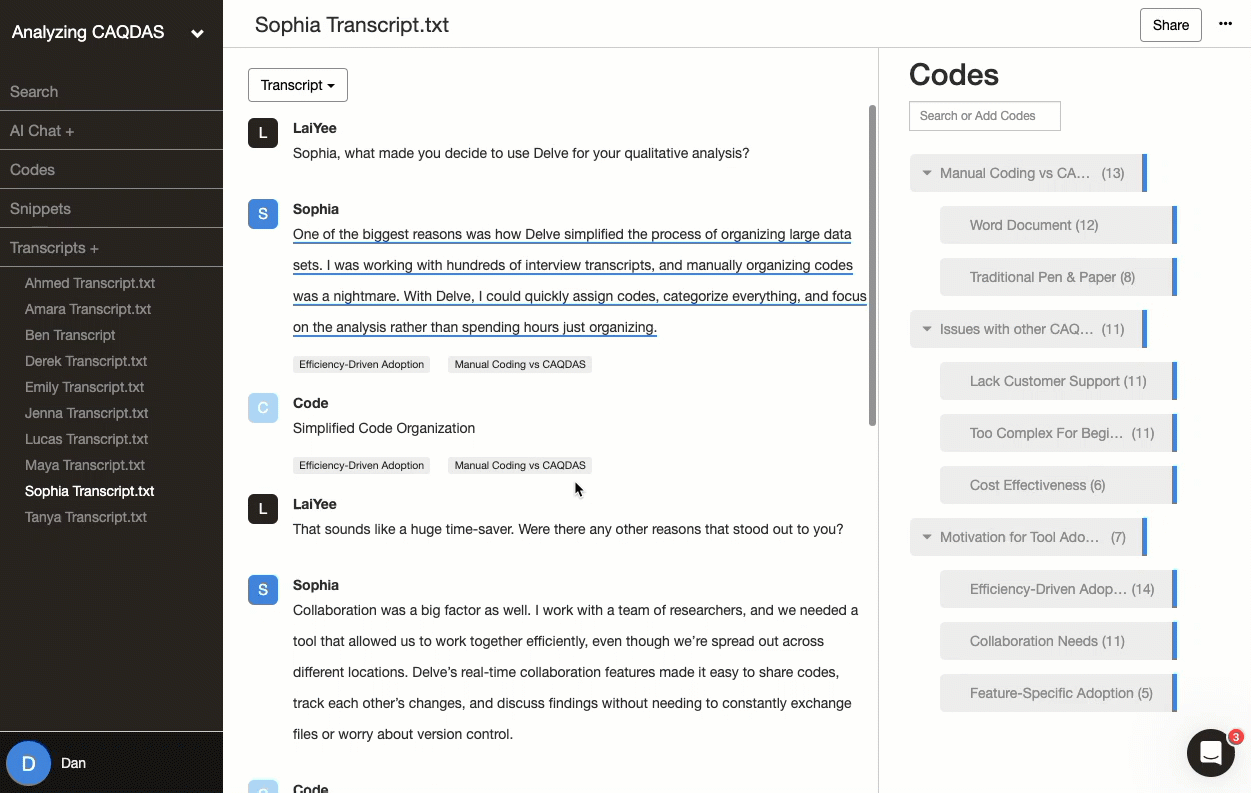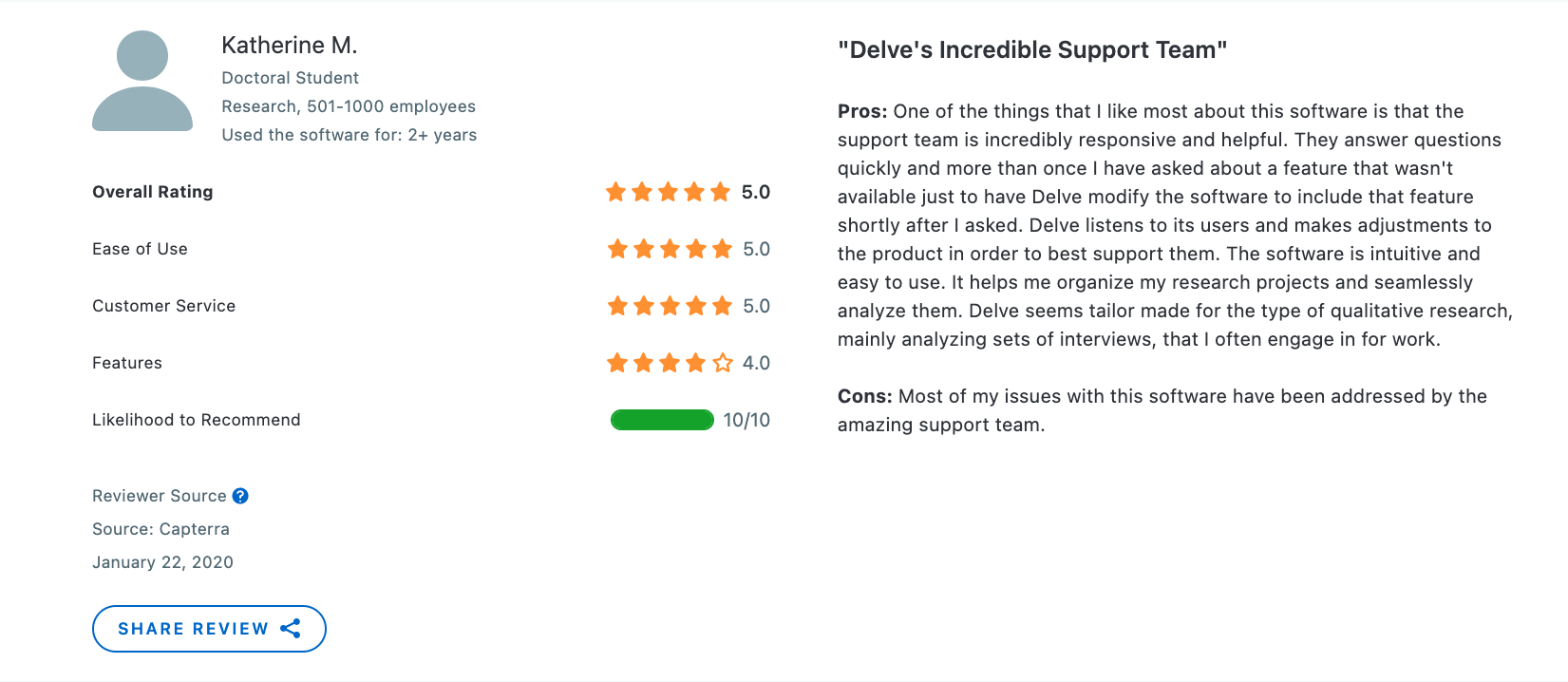How To Do Structural Coding
Structural coding uses research questions like a bookstore sorts books by genre, pre-filtering large amounts of data around key ideas or terms to avoid information overload.
Structural coding is an analysis process that orients unstructured data around your research questions. This first-cycle method helps organize oversized datasets by coding large chunks of data at a time, making it particularly useful for handling piles of interview transcripts. Think of it as laying the groundwork for more detailed second-cycle coding later.
SUMMARIZING STRUCTURAL CODING
- Say you're doing interviews about work-life balance.
- If your research question is "What strategies do people use to manage stress?" structural coding might organize sections into broad categories like "Physical Activities", "Mental Techniques", and "Social Support".
- This structuring helps you filter the data before diving into specific stress management methods within each category later.
By setting up categories based on your research questions like in the example, you generate a framework for the rest of your project early on. Aside from keeping you organized, it saves you from having to think up new plans for each study.
But, structural coding does present its own set of challenges, such as maintaining consistency across massive datasets and connecting all of your coded segments. With these roadblocks in mind, we’ll walk you through structural coding and show how Delve helps lighten the workload.
Reviewing Qualitative Coding, Structural Coding's Role
Let’s look at how structural coding works and fits into the broader qualitative coding framework, starting with the building blocks.
Qualitative Coding: Organizing Unstructured Data
You use qualitative coding to transform piles of unstructured data into a coherent narrative. It’s a proven strategy to organize interviews, field notes, and other textual information around unifying themes.
Here's the main idea:
Label Key Ideas: “Codes” are tags or short labels you apply to segments of text to capture important ideas or themes.
Find Patterns: Coding helps you spot recurring concepts or patterns in unstructured data that you think can help piece it all together.
Organize for Deeper Analysis: By categorizing data, coding sets the stage for more rigorous exploration of what the data is saying.
Structural coding kicks off this larger coding process and gives you an early sense of direction. Having early structure helps you stay focused and more methodical with where you allocate attention, which benefits new researchers who may not have much experience planning or conducting qualitative analysis.
Want to avoid the stress of information overload?
Take Delve's FREE online course to learn how to identify themes and patterns in your qualitative data. Get started here.

Structural Coding Sets the Stage
Saldaña (2009) explains structural coding as a way to organize your data around the specific questions you're trying to answer. Rather than looking for what your respondents mean, you're focusing on how different sections of the data relate directly to your research questions. For the most part, you’re sorting the data based on function at this stage, more so than your interpretation of its meaning.
Structural coding is like categorizing a bookstore or organizing a house for a move. You sort data into broad categories—like labeling boxes "Kitchen" or "Fragile" and books “Fiction” or “Kids”—without detailing every item inside. It paves the way for smoother analysis later and keeps key ideas from getting lost along the way as you unpack it.
Segmenting Data Down to Size with Structural Coding
Continuing with our work-life balance study, you might have dozens (maybe hundreds) of interview transcripts to cover in a qualitative study. Instead of getting overwhelmed by all this data, you structure your analysis around research topics or key terms.
As opposed to more granular methods like line-by-line coding, you segment larger chunks of data by paragraph, pages, or entire transcripts. The entire process is structured around your research questions.
Say you ask respondents questions like:
"How do you feel about your work-life balance?"
"What strategies do you use to manage stress in your job?"
With structural coding, you're taking sections of each transcript (or even entire transcripts) and categorizing them based on the specific question they answer. The questions themselves (or key terms derived from them) become your "labels" or codes, much like the labels on moving boxes.
💡 Delve's coding units are highly flexible and easy to apply to bulky amounts of qualitative data, ranging from single words to paragraphs, pages, and transcripts. This versatility lets you apply question-based codes at any scale, streamlining your timeline.
So if a respondent starts talking about their work-life balance or stress management techniques, that entire section of the transcript (or whole transcript) would be coded accordingly, even if they mention related topics like workload or job satisfaction.
You're essentially creating categorical buckets - like "Work-life Balance" or "Stress Management Strategies" - and sorting your data into them. The idea is that you're organizing responses according to the structure of your research questions, grouping them under broader headings that align with what you're trying to investigate–just as you'd group books in a bookstore or items before a move.
As a first-cycle coding method, structural coding is a starting point.
Understanding First-Cycle vs. Second-Cycle Coding
Saldaña calls structural coding "first-cycle coding." To review quickly, first cycle coding methods focus on organizing your data into predefined categories. It’s creating a roadmap for your analysis, making large, complex datasets more manageable to handle.
Here's how it works:
First-Cycle Coding (Using Structural Coding): You start by creating broad categories directly tied to your research questions. For example, in a study about work-life balance, you might use "WORK-LIFE BALANCE" as a structural code.
Second-Cycle Coding: Once you have your structural framework in place, you move on to second-cycle methods like pattern coding. This is where you dig deeper into each category, looking for nuances and connections.
In our work-life balance example, structural coding sets up second-cycle coding that reveals talk of flexible work hours often coincides with mentions of increased job satisfaction. This insight helps you understand how different aspects of work-life balance interconnect.
Think of it as passing the analytical torch from one stage to the next. Structural coding sets the stage, and second-cycle coding helps you uncover the deeper insights that will guide your final analysis.
💡 Delve's student-friendly coding software enhances structural coding with features like paragraph-by-paragraph coding. The simplicity of the one-click coding helps you organize, visualize, and refine your code more effectively and efficiently.
Structural Coding vs. Other First-Cycle Methods
While structural coding focuses on organizing data based on your research structure, other first-cycle methods serve similar but slightly different purposes:
In Vivo Coding: Uses participants' own language as codes
Emotion Coding: Focuses on categorizing emotions in data
Initial Coding: Breaks down data into discrete parts for close examination
Each coding method has its strengths and weaknesses. Structural coding organizes big chunks of data around research questions, but alternatives go about the process in different ways.
Structural coding can be used alongside these methods, providing a framework that complements more detailed coding approaches in the second cycle. Just keep in mind each method adds time to your project timeline!
For students and new researchers dealing with mountains of qualitative interviews for the first time, structural coding is a fantastic tool to help you avoid getting bogged down by task paralysis.
Situations for Structural Coding
Wondering when to use structural coding in the field? Structural coding is for when you’re handling a large amount of data and want strong footing with your research questions right from the start of your project.
Here’s when (and why) Saldaña suggests turning to structural coding:
You're juggling complex research questions: If your study has multiple, intertwined research questions, structural coding helps you organize your data around each one. These categories keep your analysis focused on your main objectives from the start.
Semi-structured data-gathering protocols: If you're working with interview transcripts, open-ended survey responses, or field notes from semi-structured observations, structural coding can help you organize this data efficiently.
Multiple participants, sites, or data sources: When your study involves numerous participants or data sources, structural coding provides a consistent way to categorize data across all of them.
Exploratory investigations: If you're conducting an exploratory study where you want to both code and categorize your data, structural coding offers a solid starting point.
Content-based or conceptual phrase coding: Structural coding is a great starting point for qualitative content analysis, allowing you to apply a content-based or conceptual phrase to a segment of data that relates to a specific research question.
Foundation for second cycle coding: If you plan to do more detailed coding later, structural coding sets up a great framework for further analysis. This is particularly useful for research approaches like grounded theory or thematic analysis.
Mixed methods studies: Saldaña finds structural coding well-suited for mixed methods studies because it bridges qualitative and quantitative data, allowing you to organize and analyze both types within a single study
Team research projects: When doing collaborative qualitative analysis with a team, structural coding provides an easy-to-understand, question-based framework that helps you and your team apply the code consistently.
Whether you're a solo researcher tackling a complex project or part of a team working on a large-scale study, structural coding provides a solid foundation for your broader qualitative analysis.
💡 With Delve, you can easily see how your codes are structured across the dataset, making it simpler to spot patterns or gaps. You can visualize your first steps to transition to more detailed analysis, whether you're looking for big themes or building out a grounded theory.
Structural coding is more than just pre-arranging your data. It's about creating a clear connection between your research questions and your data analysis process right from the get-go.
How to Do Structural Coding (Effectively)
To start your structural coding, you'll need to establish a clear framework that guides your analysis, including the tools you’re using. It starts with identifying the key topics or research questions you're investigating, which will then shape your coding process and keep you focused.
Let's walk through the process using our work-life balance study example, showing how Delve qualitative analysis tool streamlines structural coding.
1. Make a list of topics or research questions
Saldaña suggests starting off by listing the main topics or research questions that will guide your analysis. For our work-life balance study, we might use semi-structured interviews with questions like:
| Research Question | Purpose |
|---|---|
| How do you feel about your current work-life balance? | Captures overall perception |
| What strategies do you use to manage stress in your job? | Explores coping mechanisms |
| How does your work environment impact your work-life balance? | Examines external factors |
| What changes would you like to see in your workplace to improve work-life balance? | Identifies potential solutions |
These questions provide a comprehensive framework for understanding work-life balance from multiple angles. Delve lets you (and your team) set up a project for your study and incorporate these questions as analytical memos, keeping your thoughts organized throughout the analysis.
2. Turn each topic and research question into a code
Now, you take your research questions and use them as direct codes. The other option is to turn them into clear, concise codes that will streamline our analysis:
Codes for Work-Life Balance Study
Code: WORK-LIFE BALANCE PERCEPTION
Description: Captures overall perception of current work-life balance, based on the question "How do you feel about your current work-life balance?"
Code: STRESS MANAGEMENT STRATEGIES
Description: Explores coping mechanisms, derived from the question "What strategies do you use to manage stress in your job?"
Code: WORK ENVIRONMENT IMPACT
Description: Examines external factors, based on the question "How does your work environment impact your work-life balance?"
Code: DESIRED WORKPLACE CHANGES
Description: Identifies potential solutions, derived from the question "What changes would you like to see in your workplace to improve work-life balance?"
These codes directly reflect your research topic, making it easier to categorize data and keep focused on your goals. Delve software helps you quickly create these codes in your project's codebook. The simple interface allows you to create these codes quickly and add descriptions for consistency, even when working on team projects.
3. Read through the interview, and apply the code to sections relevant to your topics or research questions
As you go through your interview transcripts, apply the relevant codes to sections that address your research questions. Remember, your coding isn’t restricted to only direct answers to these questions. Any relevant information should be coded accordingly.
For example, when an interviewee (let’s call him Ben) says, "I feel stressed because my work hours are unpredictable," you might apply both the "WORK-LIFE BALANCE PERCEPTION" and "WORK ENVIRONMENT IMPACT" codes.
This entire paragraph would be coded using the following:
1 Work-life balance perception
2 Increased anxiety
3 Work environment impact
Delve makes this process efficient with its user-friendly coding interface. You can easily highlight entire chunks (or pages) of textual data and apply multiple codes with just a few clicks. The software also lets you to view all your codes side-by-side with your transcript, making it easy to stay organized as your coding unfolds.
4. Analyze within topics or research questions
After the first pass of structural coding, you have the option to organize even further into each coded section with what Saldaña calls “sub-codes.” For instance, when examining all your excerpts coded under "STRESS MANAGEMENT STRATEGIES," you might create sub-codes to further categorize different types of strategies:
Time management techniques
Physical activities
Mental health practices
Social support systems
Delve's hierarchical coding feature allows you to create these sub-codes easily, maintaining a clear structure in your analysis. You can also use Delve's visualization tools, like co-occurrence matrices, to see how these sub-codes relate to each other and to your main codes.
TIP: As you clarify and categorize your data through structural coding, avoid overcoding—too many codes at this early stage can overcomplicate your analysis and obscure subtle insights later on.
5. Prepare for other methods of coding for further analysis
Once you've organized your data through structural coding, you can move on to other first-cycle methods or more detailed second-cycle methods like pattern coding, axial coding, or elaborative coding.
💡 Using the right tools streamlines your structural coding and shortens your timeline. Delve offers a range of features that make it easy to organize large traches of text, add memos, and collaborate in real-time every step of the way.
Second-Cycle Coding: Where to Next?
After structural coding lays the groundwork, second-cycle methods kick into gear. Here’s another look at how a couple of these options work:
Pattern Coding: As we’ve touched upon, this method groups your initial codes into broader themes, making it easier to spot recurring ideas across your work-life balance data. It's great for shaping your final narratives in thematic, content, or discourse analysis after structural coding – and/or in vivo coding (in grounded theory).
Axial Coding: Also used in grounded theory, axial coding helps you find relationships between your initial codes. For your work-life balance study, you might connect codes like "flexible hours" and "reduced stress" to build a structured framework around central concepts.
Elaborative Coding: If you're building on existing work-life balance research, this method helps refine or support earlier findings by applying them to your new dataset. It's perfect for expanding on established theories across various research approaches.
Delve makes transitioning to these second-cycle methods seamless. Its intuitive interface allows you to easily reorganize codes, visualize relationships, and track the evolution of your analysis from initial structural coding to more nuanced interpretations.
By combining structural coding with these advanced techniques, you'll be ready to draw meaningful conclusions about your data – in less time!
Overcoming Structural Coding Challenges
We’ve covered the many reasons to use structural coding in your upcoming qualitative research project.
However, it’s inevitable that you’ll run into issues trying to organize structural coding with just pen and paper or a word processor. These methods can work, but they’re time-consuming, prone to error, and make it hard to stay on task.
The good news? Delve addresses these challenges head-on in a few specific ways:
Staying Focused: Juggling separate documents for codes and transcripts is a chaotic process. Delve centralizes everything—codes, transcripts, memos, and notes—in one easily accessible space.
Tracking Code Frequency: Especially in content analysis, manually counting how often codes are used is tedious and prone to errors. Delve tracks this automatically, so you stay focused on analysis.
Time-Intensive Work: Structural coding is labor-intensive but sets you up for success. Delve streamlines this process with simple, flexible coding units, from paragraphs to full transcripts, lightening manual work while maintaining analytical depth.
💡 Using a tool built for structural coding solves many common issues you'll face during the process. We recommend Delve because it’s easy to learn, intuitive to use, and cost-effective for anyone on a budget.
Simpler Structural Coding–with Delve
While you can do structural coding by hand or Microsoft Word, using software like Delve simply makes it easier to manage your qualitative codebook. Here's why Delve is the best tool for structural coding:
Centralized codebook: Keep all your codes and their definitions in one place, a web-based place easily accessible to all team members.
Easy code application: Apply codes with a few clicks, making the coding process faster and more efficient.
Visualization tools: Use Delve's visualization features to see patterns in your coded data, which helps find relationships between codes following an initial round of structural coding. You can use spreadsheets or export .csv files to create your own graphics.
AI-enhanced coding tools: Build confidence in your research with Delve’s AI Assistant, helping spot nuanced patterns and connections in your data that might otherwise go unnoticed
Export capabilities: Easily export your coded data and analysis for use in reports or further analysis, or as a workable document you can update and edit.
Customer support: Built by researchers, support by researchers. Get timely assistance from Delve’s support team to resolve issues quickly and keep your research moving forward smoothly.
Wrapping Up
Structural coding is a tool to organize your qualitative data for maximum efficiency, especially when dealing with semi-structured interviews or large datasets. Whether you're planning to develop a grounded theory or conduct a thematic analysis, structural coding can provide an organized foundation for your entire study.
While structural coding can be done manually, tools like Delve make it more efficient, collaborative, and insightful. Whether you're a seasoned researcher or new to qualitative analysis, mastering structural coding can help you navigate your data more effectively and efficiently.
Ready to streamline your qualitative coding and structural coding strategy? Try Delve for free and experience how it enhances your structural coding and overall qualitative analysis.
Top-Rated Structural Coding Software
Check out what real Delve users are saying about our web-based, student-friendly coding software.
References
Saldaña, J. (2009). The coding manual for qualitative researchers. Sage Publications Ltd.
Cite this blog post:
Delve, Ho, L., & Limpaecher, A. (2024, October 01). How To Do Structural Coding https://delvetool.com/blog/structuralcoding

















